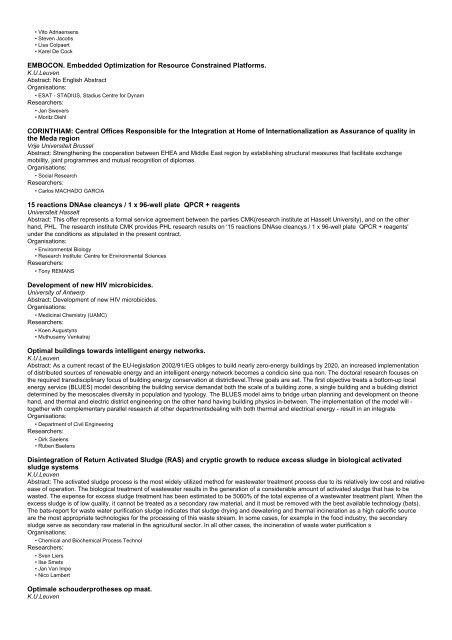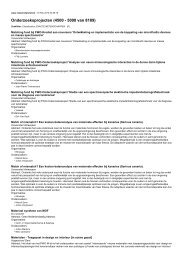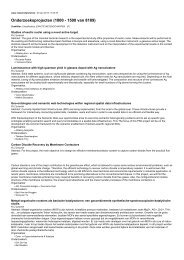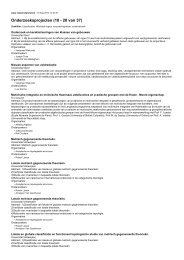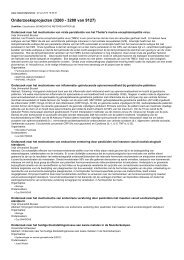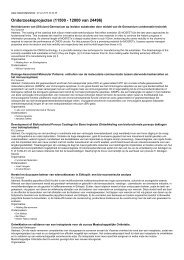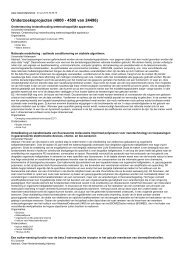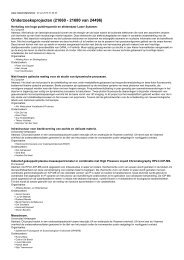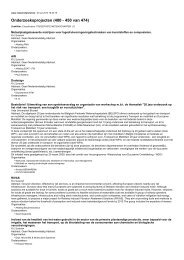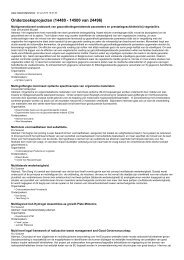Research projects (13000 - 13500 of 26984)
Research projects (13000 - 13500 of 26984)
Research projects (13000 - 13500 of 26984)
Create successful ePaper yourself
Turn your PDF publications into a flip-book with our unique Google optimized e-Paper software.
• Vito Adriaensens<br />
• Steven Jacobs<br />
• Lisa Colpaert<br />
• Karel De Cock<br />
EMBOCON. Embedded Optimization for Resource Constrained Platforms.<br />
K.U.Leuven<br />
Abstract: No English Abstract<br />
Organisations:<br />
• ESAT - STADIUS, Stadius Centre for Dynam<br />
<strong>Research</strong>ers:<br />
• Jan Swevers<br />
• Moritz Diehl<br />
CORINTHIAM: Central Offices Responsible for the Integration at Home <strong>of</strong> Internationalization as Assurance <strong>of</strong> quality in<br />
the Meda region<br />
Vrije Universiteit Brussel<br />
Abstract: Strengthening the cooperation between EHEA and Middle East region by establishing structural measures that facilitate exchange<br />
mobility, joint programmes and mutual recognition <strong>of</strong> diplomas.<br />
Organisations:<br />
• Social <strong>Research</strong><br />
<strong>Research</strong>ers:<br />
• Carlos MACHADO GARCIA<br />
15 reactions DNAse cleancys / 1 x 96-well plate QPCR + reagents<br />
Universiteit Hasselt<br />
Abstract: This <strong>of</strong>fer represents a formal service agreement between the parties CMK(research institute at Hasselt University), and on the other<br />
hand, PHL. The research institute CMK provides PHL research results on '15 reactions DNAse cleancys / 1 x 96-well plate QPCR + reagents'<br />
under the conditions as stipulated in the present contract.<br />
Organisations:<br />
• Environmental Biology<br />
• <strong>Research</strong> Institute: Centre for Environmental Sciences<br />
<strong>Research</strong>ers:<br />
• Tony REMANS<br />
Development <strong>of</strong> new HIV microbicides.<br />
University <strong>of</strong> Antwerp<br />
Abstract: Development <strong>of</strong> new HIV microbicides.<br />
Organisations:<br />
• Medicinal Chemistry (UAMC)<br />
<strong>Research</strong>ers:<br />
• Koen Augustyns<br />
• Muthusamy Venkatraj<br />
Optimal buildings towards intelligent energy networks.<br />
K.U.Leuven<br />
Abstract: As a current recast <strong>of</strong> the EU-legislation 2002/91/EG obliges to build nearly zero-energy buildings by 2020, an increased implementation<br />
<strong>of</strong> distributed sources <strong>of</strong> renewable energy and an intelligent energy network becomes a condicio sine qua non. The doctoral research focuses on<br />
the required transdisciplinary focus <strong>of</strong> building energy conservation at districtlevel.Three goals are set. The first objective treats a bottom-up local<br />
energy service (BLUES) model describing the building service demandat both the scale <strong>of</strong> a building zone, a single building and a building district<br />
determined by the mesoscales diversity in population and typology. The BLUES model aims to bridge urban planning and development on theone<br />
hand, and thermal and electric district engineering on the other hand having building physics in-between. The implementation <strong>of</strong> the model will -<br />
together with complementary parallel research at other departmentsdealing with both thermal and electrical energy - result in an integrate<br />
Organisations:<br />
• Department <strong>of</strong> Civil Engineering<br />
<strong>Research</strong>ers:<br />
• Dirk Saelens<br />
• Ruben Baetens<br />
Disintegration <strong>of</strong> Return Activated Sludge (RAS) and cryptic growth to reduce excess sludge in biological activated<br />
sludge systems<br />
K.U.Leuven<br />
Abstract: The activated sludge process is the most widely utilized method for wastewater treatment process due to its relatively low cost and relative<br />
ease <strong>of</strong> operation. The biological treatment <strong>of</strong> wastewater results in the generation <strong>of</strong> a considerable amount <strong>of</strong> activated sludge that has to be<br />
wasted. The expense for excess sludge treatment has been estimated to be 5060% <strong>of</strong> the total expense <strong>of</strong> a wastewater treatment plant. When the<br />
excess sludge is <strong>of</strong> low quality, it cannot be treated as a secondary raw material, and it must be removed with the best available technology (bats).<br />
The bats-report for waste water purification sludge indicates that sludge drying and dewatering and thermal incineration as a high calorific source<br />
are the most appropriate technologies for the processing <strong>of</strong> this waste stream. In some cases, for example in the food industry, the secondary<br />
sludge serve as secondary raw material in the agricultural sector. In all other cases, the incineration <strong>of</strong> waste water purification s<br />
Organisations:<br />
• Chemical and Biochemical Process Technol<br />
<strong>Research</strong>ers:<br />
• Sven Liers<br />
• Ilse Smets<br />
• Jan Van Impe<br />
• Nico Lambert<br />
Optimale schouderprotheses op maat.<br />
K.U.Leuven


